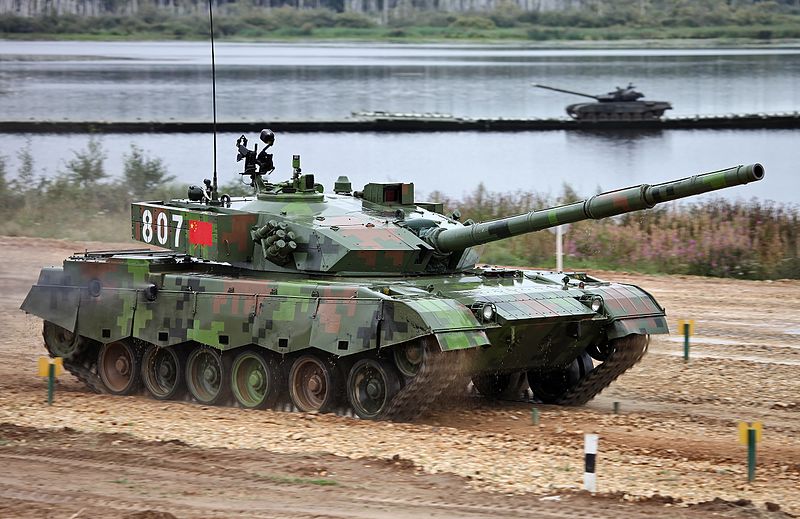Malcolm Davis and Charlie Lyons Jones

Unlike China’s relatively cogent thinking on future warfare in the air, maritime, cyber and space domains, its thinking on land combat has been increasingly incoherent. Indeed, the strategic priorities the Chinese Communist Party has been setting for the military since the 1980s have required a shift in emphasis from land power to air and sea power. With the Soviet Union gone and China’s land borders largely settled (disputes with India notwithstanding), the People’s Liberation Army Ground Force (PLAGF) has struggled to find a meaningful purpose in China’s future force structure beyond sustaining the capability needed to win a limited war on the Sino-Indian border.
Some of the incoherence is best laid out by military commentators within China itself. In an article in the People’s Liberation Army Daily, Wang Ronghui seeks to explore the role armoured forces will have in future warfare. Writing with much jargon and little detail, Wang argues that the recent history of armed conflict has confirmed the armoured forces’ role as the ‘king of land warfare’ (陆战之王).
Armoured forces, Wang observes, have proved adept at ‘incorporating highly advanced weapons technology’. Equipment such as armoured fighting vehicles and main battle tanks have become sufficiently flexible and adaptable to changes on an information-dense battlefield. Without providing much evidence, Wang argues that these characteristics of armoured warfare have effectively disproved the ‘useless tank theory’ (坦克无用论).
After beginning the essay with vague statements about the nature of land warfare, Wang moves on to provide a strategic rationale for why the PLAGF needs a strong armoured force. ‘Armoured forces have important missions in resolving territorial disputes, resisting foreign invasion, stabilising borders and safeguarding territory along with other warfighting roles’, he says.
There are significant issues with this line of argument. Not only have China’s land borders largely been settled, but, on the one land border that China hasn’t settled, namely with India in the Himalayan mountains, armoured forces would find it extremely hard to operate as the terrain is extremely rugged. Absent a critical security threat, the main uses of armoured forces would be for stabilisation missions along the North Korean border, exercises in Central Asia with members of the Shanghai Cooperation Organization and, perhaps, in a land invasion of Russia or Mongolia. What this suggests is that China’s land warfare thinkers are struggling to find a sustainable role for armour in the PLA’s force structure.
With those thoughts in mind, what does the future hold for the PLA’s ground forces? Politically, the PLAGF has always been the dominant force in the Central Military Commission. Yet China’s 2015 defence white paper emphasised that the PLAGF needed greater mobility between theatres, and suggested an emphasis on small, multifunctional and modular units that would enable the PLAGF to adapt itself to tasks in different regions.
This emphasis on greater mobility and flexibility is influencing capability development and shaping the nature of military exercises, with a growing emphasis on combined arms mechanisation, and joint and integrated military operations. The 2019 defence white paper notes that the PLAGF ‘is speeding up the transition of its tasks from regional defense to trans-theater operations, and improving the capabilities for precise, multi-dimensional, trans-theater, multi-functional and sustained operations, so as to build a new type of strong and modernized land force.’
More recently, there have been indications that a goal in the 14th Five Year Plan (2021–2025) will be to accelerate military modernisation so that the PLA will be fully mechanised and informationised by 2027—the 100th anniversary of its founding. Chinese military expert Dean Cheng argues that that will require a major reduction in forces, a major budget increase or a redefining of what constitutes ‘informationised’ units.
The lingering effects of Covid-19 on the Chinese economy are likely to place pressure on the defence budget, forcing the PLA to focus more on developing a streamlined, ‘meaner but leaner’ military. With the PLA Navy, Air Force, Rocket Force and Strategic Support Force eating up most of the funding, it’s possible that the PLAGF will face further cuts.
The challenge for the PLAGF leadership is seeing this as an opportunity rather than a risk. Trimming the fat by scrapping outdated capabilities and reshaping army organisation to be better prepared for warfare in a variety of operational theatres would the PLAGF to play a more even role alongside air, naval, space and missile forces. That could mean lighter, more agile and mobile ground forces, integrated with army aviation and long-range fires, as well as a greater focus on embracing technology such as lethal autonomous weapons.
China’s military is facing the same challenges as most of the world’s armed forces—how to transform and adapt to new approaches to operations and new types of technology within constrained budgets. For the PLAGF leadership, that may mean having the courage to throw off old capabilities that were suited towards ‘people’s war under modern conditions’ in the 1980s and instead move decisively towards integrated joint operations as part of informationised and intelligentised warfare for the 21st century. It also means prioritising an ability to deploy rapidly across multiple theatres within China and to project force beyond China.
Given that the principal strategic direction for the PLA remains ‘reunification’ with Taiwan and, more broadly, China’s littoral in the western Pacific, the PLAGF must have the ability to be an expeditionary force. Getting bogged down with heavy armour may be the wrong move.
The requirement for nimble, expeditionary forces that can operate in an information-dense environment should shape the future capability development of the PLAGF in coming years. The question is whether it will.
No comments:
Post a Comment